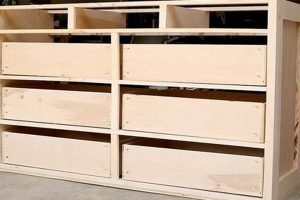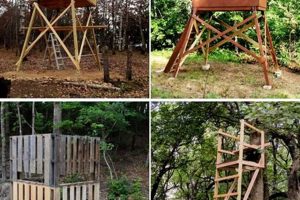The concept revolves around constructing a protective structure against the destructive forces of tornadoes using self-directed methods. These projects encompass a range of designs, from reinforced safe rooms within existing homes to underground bunkers built independently. An example includes reinforcing an interior closet with steel plating and concrete to create a secure haven.
Such undertakings offer individuals a heightened sense of security and control over their safety during severe weather events. Historically, seeking refuge in dedicated shelters has proven effective in minimizing tornado-related injuries and fatalities. The availability of accessible construction techniques empowers individuals to proactively enhance their resilience to natural disasters, particularly in regions prone to tornadic activity.
The following sections will delve into various aspects of constructing these protective spaces, including design considerations, material selection, building codes, and essential safety precautions. Careful planning and execution are paramount to ensure structural integrity and optimal protection.
Essential Guidance for Constructing a Personal Storm Shelter
This section provides crucial recommendations for those undertaking the construction of a personal storm shelter. Adherence to these guidelines is essential for ensuring structural integrity and occupant safety.
Tip 1: Site Selection is Paramount: Choose a location that is readily accessible from the main dwelling but is also free from potential hazards such as flood zones or buried utility lines. The surrounding soil should be stable and well-draining.
Tip 2: Adhere to Building Codes and Regulations: Consult local building codes and regulations pertaining to storm shelter construction. Compliance ensures that the structure meets minimum safety standards and avoids legal complications.
Tip 3: Employ Engineering Expertise: Seek professional guidance from a structural engineer to validate the design. An engineer can assess the structural integrity of the shelter and recommend necessary modifications to withstand extreme wind loads and impact forces.
Tip 4: Reinforce Concrete Structures Adequately: If utilizing concrete, ensure adequate reinforcement with steel rebar. The rebar should be properly spaced and tied to provide tensile strength and prevent cracking under stress.
Tip 5: Secure Anchoring is Critical: The shelter must be securely anchored to the ground to prevent uplift during a tornado. Employ appropriate anchoring systems, such as ground anchors or concrete footings, designed to resist the anticipated uplift forces.
Tip 6: Ventilation and Egress are Necessary: Incorporate adequate ventilation to ensure breathable air within the shelter. Design a clear and accessible egress route, considering potential debris blockage after a storm.
Tip 7: Stock Emergency Supplies: Equip the shelter with essential emergency supplies, including water, non-perishable food, a first-aid kit, a weather radio, and a flashlight. Regular inspection and replenishment of these supplies are imperative.
Diligent application of these recommendations during the planning and construction phases will significantly enhance the safety and effectiveness of the personal storm shelter. Such preparations are a vital investment in personal and family security.
The subsequent sections will offer a detailed exploration of design considerations and maintenance procedures, further empowering individuals to create a robust and reliable refuge from severe weather events.
1. Structural Integrity
Structural integrity is paramount within the context of constructing a personal storm shelter. It represents the capacity of the structure to withstand the extreme forces generated by tornadic winds and flying debris. Compromised structural integrity directly correlates with an increased risk of collapse and subsequent injury or fatality for occupants. Effective designs, therefore, prioritize robust construction techniques and the selection of durable materials to create a resilient protective environment. Failures stemming from insufficient structural resilience during tornadic events underscore the dire consequences of neglecting this critical aspect. A concrete shelter with inadequately reinforced walls, for example, may be unable to withstand the impact of debris, leading to structural failure.
The specific design and construction methods employed directly impact the shelter’s ability to maintain its structural integrity under duress. Reinforced concrete, steel, and timber are often utilized, each requiring careful consideration of load-bearing capacity and resistance to impact. Engineering calculations and adherence to building codes are necessary to ensure the structure can withstand anticipated wind loads and projectile impacts. For instance, the depth and spacing of reinforcing bars in concrete walls are crucial to the overall strength of the shelter. Similarly, the anchoring system must be capable of resisting uplift forces that can result from high winds.
In summary, achieving a high degree of structural integrity is non-negotiable in the design and construction of a personal storm shelter. Rigorous adherence to established engineering principles, careful material selection, and diligent construction practices are essential to ensure occupant safety. Neglecting this crucial aspect renders the shelter ineffective and potentially hazardous, underscoring the critical importance of prioritizing robust structural performance. The ultimate goal is to create a safe space that reliably protects individuals from the destructive forces of tornadoes.
2. Anchoring Systems
Anchoring systems represent a fundamental component in the successful implementation of personal storm shelters. Their primary function is to resist the uplift forces generated by tornadic winds, thereby preventing the shelter from being dislodged or overturned during a severe weather event. The proper selection and installation of an anchoring system are therefore paramount in ensuring the shelters structural integrity and the safety of its occupants.
- Uplift Resistance Capacity
This refers to the anchoring systems ability to withstand the upward forces exerted by high winds. The calculated uplift resistance must exceed the expected wind loads based on regional weather data and shelter dimensions. Improperly sized or installed anchors can fail under pressure, rendering the shelter vulnerable. For example, a shelter in a high-risk tornado zone requiring 10,000 lbs of uplift resistance must employ an anchoring system that meets or exceeds this specification.
- Types of Anchoring Methods
Various anchoring methods exist, including ground anchors, concrete footings, and helical piers. Ground anchors are driven deep into the earth and are suitable for smaller shelters. Concrete footings involve embedding the shelters base within a reinforced concrete foundation, providing a substantial connection to the ground. Helical piers are screwed into the ground, offering high load-bearing capacity in various soil conditions. The choice of method is contingent upon soil type, shelter size, and anticipated wind loads.
- Installation Precision
The effectiveness of any anchoring system hinges on precise installation. Adherence to manufacturer specifications is critical, including proper anchor spacing, depth, and orientation. Incorrect installation techniques can significantly reduce the systems uplift resistance capacity. For instance, failure to achieve the specified torque during ground anchor installation can compromise its holding power.
- Corrosion Protection
Anchoring systems, particularly those installed underground, are susceptible to corrosion. Employing corrosion-resistant materials, such as galvanized steel or epoxy-coated anchors, is essential to ensure long-term performance. Regular inspections and maintenance can help identify and address corrosion issues before they compromise the systems integrity. Neglecting corrosion protection can lead to premature failure, especially in areas with high soil moisture or salinity.
In summary, the anchoring system represents a critical line of defense in ensuring the safety and efficacy of a personal storm shelter. Proper selection, precise installation, and ongoing maintenance are essential to counteract the uplift forces generated by tornadic winds. A compromised anchoring system can negate all other protective features of the shelter, underscoring the necessity of meticulous attention to this aspect of design and construction. The consequences of underestimating the role of anchoring systems underscore the need for a comprehensive and rigorously implemented approach to securing personal storm shelters.
3. Ventilation Requirements
Adequate ventilation within structures designed for refuge from tornadic events is a non-negotiable aspect of their design and implementation. It is a critical factor that directly impacts the survivability of occupants during and following the occurrence of severe weather. An understanding of the principles governing airflow and air quality within confined spaces is paramount for successful shelter construction.
- Oxygen Replenishment
The primary role of ventilation is to ensure a sufficient supply of breathable air for all occupants. A confined space lacking proper ventilation will experience a depletion of oxygen, leading to hypoxia and potentially unconsciousness. The rate of oxygen consumption is dependent upon the number of occupants and their activity levels. Therefore, ventilation systems must be sized to accommodate the maximum anticipated occupancy of the shelter. Consideration must be given to the potential for extended shelter use in the event of prolonged weather events or debris blockage of egress routes. An example includes a family of four sheltering for several hours requiring a minimum calculated airflow to maintain safe oxygen levels.
- Carbon Dioxide Removal
Human respiration generates carbon dioxide as a byproduct. Elevated levels of carbon dioxide within a confined space can lead to hypercapnia, characterized by symptoms such as headache, dizziness, and shortness of breath. Effective ventilation facilitates the removal of exhaled carbon dioxide, maintaining air quality within acceptable parameters. The concentration of carbon dioxide is directly related to the number of occupants and the ventilation rate. Therefore, appropriate ventilation systems must be designed to prevent the buildup of carbon dioxide to dangerous levels. For example, a shelter with inadequate ventilation can accumulate carbon dioxide, leading to discomfort and impaired cognitive function among occupants.
- Humidity Control
Ventilation plays a crucial role in regulating humidity levels within the shelter. High humidity promotes the growth of mold and mildew, which can pose health risks to occupants, particularly those with respiratory sensitivities. Additionally, high humidity can create an uncomfortable environment, potentially leading to dehydration and heat stress. Ventilation systems facilitate the exchange of air, reducing moisture buildup and maintaining a more comfortable and healthful environment. For example, ventilation systems may incorporate dehumidification components or passive ventilation strategies to mitigate humidity concerns.
- Filtration Considerations
In addition to providing fresh air, ventilation systems can incorporate filtration mechanisms to remove airborne particulate matter and contaminants. During a tornado, dust, debris, and other pollutants may be drawn into the shelter through ventilation openings. Filtration systems can improve air quality by removing these contaminants, protecting occupants from respiratory irritation and potential health hazards. High-efficiency particulate air (HEPA) filters are often employed to capture fine particles, improving the overall air quality within the shelter. For example, a ventilation system equipped with a HEPA filter can reduce the concentration of airborne dust and allergens, creating a cleaner and safer environment.
In conclusion, addressing ventilation requirements is inextricably linked to the successful creation of personal storm shelters. Effective ventilation provides a continuous supply of breathable air, removes harmful gases, regulates humidity, and filters out contaminants. These factors are essential to ensuring the health, safety, and survivability of occupants during and following severe weather events. Neglecting ventilation design can result in hazardous conditions and compromise the effectiveness of the entire shelter.
4. Accessibility
Accessibility constitutes a critical yet frequently overlooked element within “diy tornado shelter plans”. It directly impacts the ability of all individuals, including those with mobility limitations, disabilities, or age-related challenges, to effectively utilize the shelter during a severe weather event. Inadequate accessibility can render a shelter functionally useless for a significant portion of the population, negating the intended safety benefits. A shelter design that requires navigating steep steps or narrow doorways, for example, effectively excludes individuals using wheelchairs or those with impaired balance. The consequence is heightened vulnerability during emergencies.
Practical considerations for accessibility encompass a range of design features. Ramps with appropriate gradients provide an alternative to steps, ensuring wheelchair users can enter and exit the shelter independently. Wide doorways accommodate mobility devices and allow for assistance from caregivers if needed. Interior space must be sufficient to allow for maneuverability. Visual and auditory alerts can further enhance accessibility for individuals with sensory impairments. Integrating these features necessitates careful planning and may influence the overall shelter design and construction costs. The added expense, however, represents a crucial investment in inclusivity and equitable access to safety. Furthermore, ensuring clear and unobstructed pathways to the shelter from the primary residence is paramount.
Ultimately, the integration of accessibility principles into “diy tornado shelter plans” is not merely a matter of compliance but a moral imperative. It ensures that all members of the community have an equal opportunity to seek refuge and protection during a tornado. The failure to address accessibility effectively undermines the very purpose of a storm shelter: to safeguard human life. The proactive inclusion of accessible design features is essential for creating shelters that are truly inclusive and effective for all individuals, regardless of their physical abilities or limitations.
5. Material Selection
Material selection holds profound significance within the context of “diy tornado shelter plans.” The structural integrity, longevity, and overall effectiveness of the shelter are directly contingent upon the materials chosen for its construction. Employing substandard or inappropriate materials can compromise the shelters ability to withstand extreme forces generated by tornadic winds and flying debris, potentially leading to catastrophic failure. For instance, using unreinforced concrete blocks or improperly treated timber will likely result in structural weakness and vulnerability to impact. The correct selection of durable, high-strength materials is therefore a non-negotiable element in ensuring the safety and protection of occupants.
Several factors influence the material selection process. These include the design of the shelter, the anticipated wind loads based on regional weather data, soil conditions, budget constraints, and adherence to building codes. Commonly used materials encompass reinforced concrete, steel, and timber, each possessing distinct advantages and disadvantages. Reinforced concrete provides excellent compressive strength and resistance to impact, but requires careful mixing and curing. Steel offers high tensile strength and ductility, but is susceptible to corrosion if not properly treated. Timber, when pressure-treated, can be a cost-effective option, but it must be adequately protected from moisture and insect damage. An example illustrates this point: a homeowner choosing to build an underground shelter might opt for reinforced concrete walls and a steel roof to maximize protection against both wind and potential ground collapse.
In conclusion, informed material selection represents a critical determinant of success in “diy tornado shelter plans.” The chosen materials directly influence the shelters ability to withstand the destructive forces associated with tornadoes. Careful consideration must be given to structural requirements, environmental factors, and budgetary limitations to ensure the selection of appropriate materials that provide optimal protection and longevity. Neglecting this aspect undermines the entire purpose of the shelter, potentially exposing occupants to significant risk. Thus, a thorough understanding of material properties and performance characteristics is paramount for anyone undertaking the construction of a personal storm shelter.
6. Building Codes
Building codes represent a fundamental regulatory framework governing the design, construction, and maintenance of structures, including personal storm shelters. The primary objective of these codes is to ensure public safety and welfare by establishing minimum standards for structural integrity, fire resistance, and accessibility. Compliance with applicable building codes is not merely a legal requirement but a critical imperative in the context of “diy tornado shelter plans.” Failure to adhere to relevant codes can result in structurally deficient shelters that fail to provide adequate protection during severe weather events, potentially leading to injury or loss of life. For example, if building codes stipulate specific concrete mix ratios and rebar spacing for reinforced concrete walls, neglecting these requirements can significantly reduce the wall’s capacity to withstand impact from flying debris.
The specific building codes applicable to “diy tornado shelter plans” vary depending on the jurisdiction and the type of shelter being constructed. Many municipalities have adopted the International Building Code (IBC) and the International Residential Code (IRC), which contain provisions relating to storm shelters and high-wind construction. These codes typically address aspects such as foundation requirements, wall and roof construction, anchoring systems, and ventilation. Moreover, some states and local governments have enacted specific regulations pertaining to storm shelters, often exceeding the minimum requirements outlined in the IBC and IRC. Understanding and complying with these specific local regulations is essential. As an example, a homeowner constructing an underground shelter might be required to obtain a building permit, submit detailed structural plans for review, and undergo inspections throughout the construction process to ensure code compliance.
In summary, building codes serve as a crucial safeguard in the execution of “diy tornado shelter plans.” Adherence to these codes ensures that the shelter meets minimum safety standards, enhancing its ability to protect occupants during a tornado. Failure to comply not only exposes individuals to increased risk but can also result in legal ramifications. Thorough research, consultation with local building officials, and diligent adherence to all applicable codes are therefore indispensable for anyone undertaking a “diy tornado shelter plans” project. The practical significance lies in the enhanced safety and peace of mind derived from knowing that the shelter is built to withstand the forces it is intended to resist, thereby providing a reliable refuge during severe weather emergencies.
7. Emergency Supplies
The integration of emergency supplies within “diy tornado shelter plans” transcends mere convenience; it represents a critical life-sustaining element. The cause-and-effect relationship is direct: while the shelter provides physical protection from the storm’s immediate impact, emergency supplies mitigate the consequences of potential entrapment, injury, or prolonged isolation. The absence of such supplies renders the shelter incomplete, addressing only half the risk. A reinforced concrete structure offers little benefit if its occupants succumb to dehydration or injury due to a lack of provisions. For instance, a family trapped in a shelter for several hours following a tornado owes its survival not only to the shelter’s walls but also to the stored water, food, and first-aid kit.
The practical application of this understanding necessitates careful planning and preparation. Emergency supplies should be specifically tailored to the anticipated duration of shelter use and the potential needs of its occupants. This includes non-perishable food items with a long shelf life, sufficient potable water, a comprehensive first-aid kit with essential medications, a battery-operated or hand-crank weather radio for obtaining vital information, flashlights with extra batteries, blankets or sleeping bags for warmth, and tools for potential extrication. Furthermore, these supplies must be regularly inspected and replenished to ensure their efficacy. A real-world example involves a community where residents were stranded in shelters for over 24 hours due to widespread debris; those with adequate emergency supplies experienced significantly better outcomes than those without.
In conclusion, emergency supplies constitute an indispensable component of comprehensive “diy tornado shelter plans”. The provision of these resources is not an afterthought but a proactive measure that directly enhances the likelihood of survival and well-being following a tornado. Challenges include accurately assessing potential needs and maintaining supply readiness over time. However, the profound practical significance of emergency suppliestransforming a potentially fatal situation into a manageable oneunderscores their essential role in a complete shelter strategy. The focus should consistently remain on optimizing the shelters capacity to sustain life in the event of unforeseen circumstances, cementing the connection between physical protection and resourcefulness.
Frequently Asked Questions
The following section addresses common inquiries and misconceptions regarding the design and construction of personal storm shelters. The information presented is intended to provide clarity and promote safe construction practices.
Question 1: Are self-built tornado shelters as safe as commercially manufactured units?
The safety of any tornado shelter, whether self-built or commercially manufactured, depends entirely on its design, construction quality, and adherence to relevant building codes. A poorly designed or constructed commercially available shelter can be less safe than a well-engineered and properly built “diy tornado shelter plans”.
Question 2: Is a building permit required for constructing a personal storm shelter?
The requirement for a building permit is determined by local jurisdictional regulations. It is imperative to consult with local building officials to ascertain specific permit requirements prior to commencing any construction activity.
Question 3: What is the minimum size recommended for a personal storm shelter?
The minimum size recommendation depends on the anticipated number of occupants. Shelter design should allocate adequate space for each individual to sit comfortably and store essential emergency supplies. Consultation with engineering professionals is advisable.
Question 4: Can an existing basement be retrofitted into a tornado shelter?
While basements can provide some degree of protection, they are not inherently tornado-proof. Retrofitting an existing basement to meet storm shelter standards requires significant structural reinforcement, including reinforced walls and a secure ceiling.
Question 5: What type of ventilation is necessary for a personal storm shelter?
Adequate ventilation is crucial for maintaining breathable air quality within the shelter. Ventilation systems should provide sufficient airflow to replenish oxygen and remove carbon dioxide. Passive or mechanical ventilation systems can be employed, ensuring protection from debris intrusion.
Question 6: What is the estimated cost associated with constructing a “diy tornado shelter plans”?
The cost varies significantly depending on the shelter design, size, materials used, and labor expenses. Underground shelters typically cost more than above-ground safe rooms due to excavation and specialized construction requirements. A detailed cost analysis is recommended prior to commencing construction.
The key takeaway is that construction represents a significant undertaking requiring careful planning, adherence to building codes, and a thorough understanding of structural engineering principles.
The subsequent section will address maintenance procedures and long-term shelter upkeep.
diy tornado shelter plans
This exploration of “diy tornado shelter plans” has underscored the complexity and responsibility involved in creating personal storm shelters. Key considerations include structural integrity, anchoring systems, ventilation, accessibility, material selection, building code compliance, and emergency supplies. Each element requires meticulous planning and execution to ensure optimal protection during severe weather events.
The decision to embark on “diy tornado shelter plans” demands careful consideration of resources, expertise, and commitment. While offering a sense of control and potential cost savings, such projects necessitate a rigorous adherence to established safety standards and a thorough understanding of engineering principles. Prioritizing safety and consulting with qualified professionals are paramount to creating a reliable refuge and safeguarding lives. The ultimate goal is to construct a shelter that provides genuine security and peace of mind in the face of nature’s most destructive forces.



![Best DIY Slide In Truck Camper Plans [Easy Build Guide] The DIY Hub: Creative Crafts, Repairs & Life Hacks Best DIY Slide In Truck Camper Plans [Easy Build Guide] | The DIY Hub: Creative Crafts, Repairs & Life Hacks](https://craftingdiycenter.com/wp-content/uploads/2025/07/th-1432-300x200.jpg)



